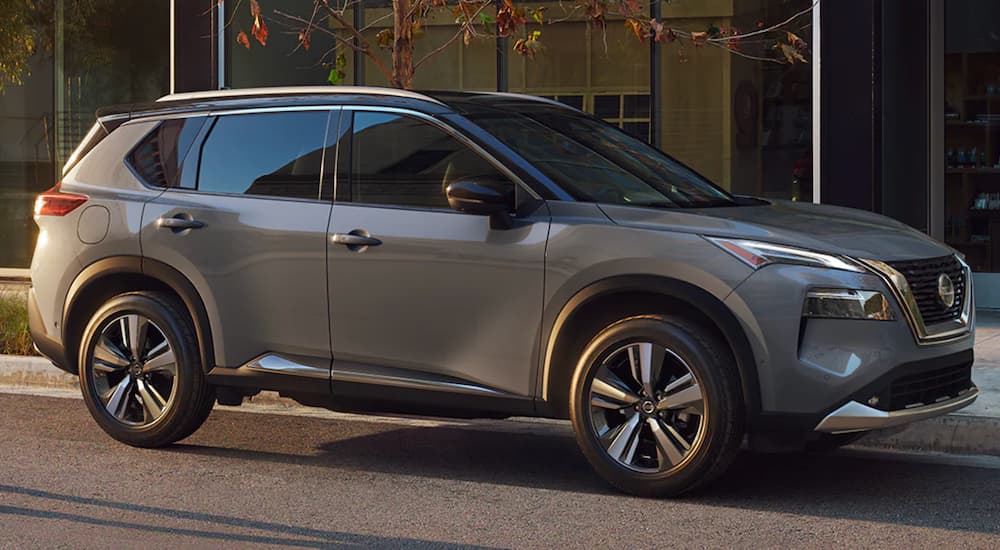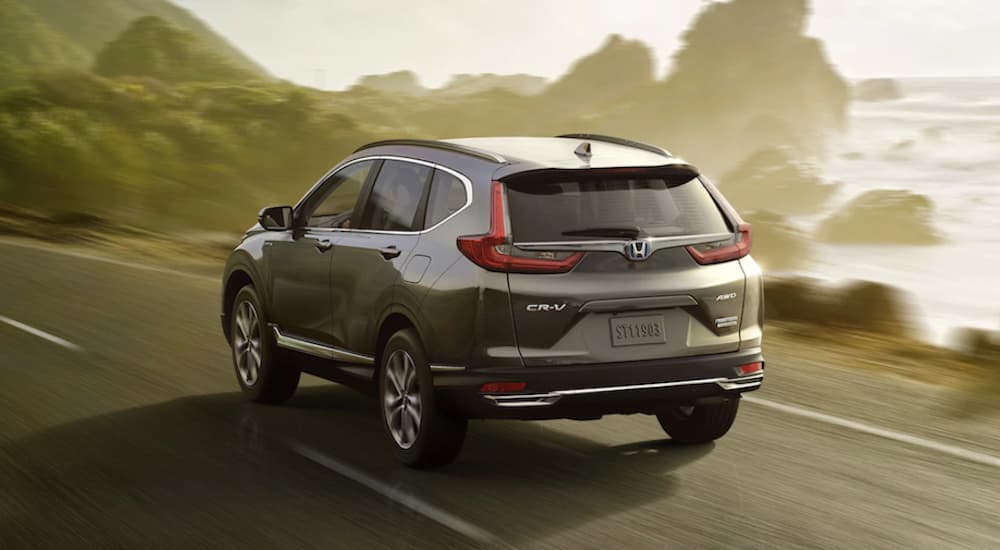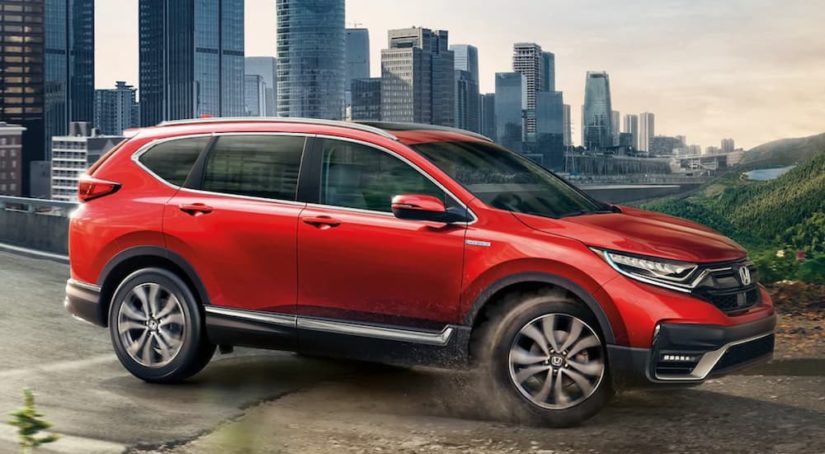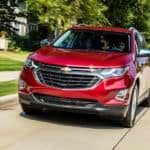Because the 2021 Nissan Rogue is all-new and shiny, everyone is excited to take it out for a test drive. Admittedly, it does look great in the top trims with lots of upscale interior styling, and it has lots of tech to smother drivers and passengers alike. And yet, the 2021 Honda CR-V smothers the sales of the Nissan Rogue with ease. When you look at the numbers for both 2020, the CR-V beat the Rogue with a difference of roughly 100,000 units. But it’s not just the sales figures that make this comparison interesting. If you look at the 2021 Honda CR-V vs 2021 Nissan Rogue under the lights of other qualitative inspections, you discover a number of interesting facts and figures.
Pricing
Both the 2021 CR-V and 2021 Rogue occupy a similar price range, but the CR-V starts out lower for its entry-level models and ends at a lower price for its range-topping model. Honda prices the 2021 CR-V at $25,350 for the LX trim, and the top-tier Touring trim starts at $33,650. Nissan starts pricing for the 2021 Rogue at $25,850 for the S Trim, and the top-tier Platinum trim starts at $35,630. In this face-off, the CR-V has the advantage.
Fuel Efficiency
Fuel costs for SUVs can often be high. They tend to be thirsty vehicles, but Honda is a brand that does its best to mitigate such expenses. For the 2021 CR-V, a front-wheel drive model gets 30 mpg combined, and the all-wheel drive model gets 29 mpg combined. The available hybrid models get stellar fuel efficiency at 38 mpg combined.
Looking at the 2021 Rogue, the front-wheel drive model manages 30 mpg combined, and the all-wheel drive model ekes out 29 mpg combined. However, the old Rogue Hybrid was discontinued back in 2019, leaving Nissan without an option for drivers seeking maximum efficiency. Adding in the CR-V’s option for a hybrid really kicks the Nissan Rogue out of the range of Honda’s fuel efficiency.

Trim Levels
When comparing trim levels, there are two means of determining which brand offers the better value: the number of trims and available features. In terms of features, these two SUVs are rather similar, with only minor differences. With that said, Honda offers five trim levels for the standard CR-V and three trims for the CR-V Hybrid. Nissan only offers four trim levels for the Rogue. Period. If you want choices, the Honda CR-V has more of them. If you want features, Nissan has them, but you will have a more difficult time building your perfect SUV.
Performance
Both SUVs are powered by four-cylinder engines paired with a continuously variable transmission. Though Nissan did improve over the Rogue’s previous engine, the new 2.5-liter still trails the CR-V’s engine and makes only 181 horsepower. Honda edges out the Nissan with its 1.5-liter turbocharged engine that makes 190 horsepower, which means the CR-V is better at taking off from stops and can pass other cars more readily on the highway. The CVT in the Nissan is also much louder at higher speeds and can tend to lag when accelerating.
Another aspect of performance is handling. Again, the 2021 Rogue shows improvement over its previous generation, particularly with the multi-link suspension for the rear, and its ride quality is smoother. Unfortunately for the Rogue, Honda has been to this rodeo before. With better capability for off-road driving, a firmer feel to the steering and cornering, and a smoother ride quality on the road, the 2021 CR-V easily out-performs the Rogue.
Interior Space
When you buy an SUV, you probably like the idea of more space for both passengers and cargo. After all, if you purchase a vehicle that costs more to fuel, it’s nice if you get the benefit of being able to utilize more space. Both SUVs have the capacity for five passengers, and rear-seat legroom in the 2021 Rogue measures 38.5 inches, a good amount of room. The 2021 CR-V, however, offers rear-seat passengers 40.4 inches of legroom, which is a fairly big difference for taller passengers. Adults will be more comfortable in the Honda.
Cargo space in the Nissan Rogue amounts to 36.5 cubic feet for the rear trunk, and when the rear seats are folded down, it grows to 74.1 cubic feet. That’s fairly generous space, though once again, the Honda CR-V is larger, with 39.2 cubic feet in the rear area and 75.8 cubic feet with the seats folded. And that’s using Nissan’s higher numbers without the moonroof – choosing that option shrinks the cargo area even more. For passenger comfort and cargo space, the 2021 CR-V wins hands down.
Safety Ratings
It’s fair to say that when comparing the safety features in terms of the driver-assist technology available on both SUVs, Nissan does have a large array of features across all its Rogue trims. Of course, Honda has been known for its active and passive safety features, as well as its structural design, for many years and has built a reputation for earning high scores on safety from both the NHTSA and the IIHS. Honda gives the 2021 CR-V a generous suite of driver-assist technology on every trim, too, but it has one thing the 2021 Rogue couldn’t get: a five-star safety rating.
In testing from the NHTSA, the 2021 Rogue did not perform as well as the 2021 CR-V. In fact, the Rogue only earned four stars overall, in front crash tests, and for rollover tests. Meanwhile, the CR-V earned five stars in front and side crash tests, proving that even with its fancy tech, the Nissan isn’t as safe as the Honda.

Resale Value
When it comes to resale value, it’s hard to beat a Honda. Few brands can match the reputation Honda has built for itself, and unfortunately, Nissan simply hasn’t got there yet. For 2021, the CR-V earned a rating of 89/100 on JD Power for resale value, which is excellent. The 2021 Rogue has earned a high score of 86/100, which is also excellent but still not as high as the CR-V. If you only plan to own your SUV for a few years and then sell it for a new one, you’re better off with the Honda CR-V.
Technology
Nissan delivers more technology in the entry-level trim than Honda, and in each trim, it has a larger touchscreen with more intuitive tech. Both offer a trial of Sirius XM for three months, and both SUVs come with connected services. For the 2021 CR-V, connected services start with the second trim level, and they include 24-hour roadside assistance as a complimentary service. Nissan offers six months of service before requiring a subscription, though the service does include security and emergency service for that time. Both vehicles offer Apple CarPlay and Android Auto, Amazon Alexa connectivity, wireless charging, and WiFi. In some ways, it seems like Nissan has the upper hand in tech, but Honda holds its own other than in the base trim. Still, the 2021 Rogue takes this round.
Final Verdict
From pricing to resale value, in almost every category, the 2021 Honda CR-V beats the 2021 Nissan Rogue, especially for safety. The 2021 CR-V is simply the top choice in a direct comparison of these two SUVs in terms of pricing, value, and performance. Even though both SUVs are top sellers for their brands, the 2021 Honda CR-V is the top seller overall. If you’re searching for the best value in a compact SUV, the 2021 Honda CR-V has better fuel efficiency and resale value, offers more space, and you can drive confidently, knowing it’s the safer choice.



